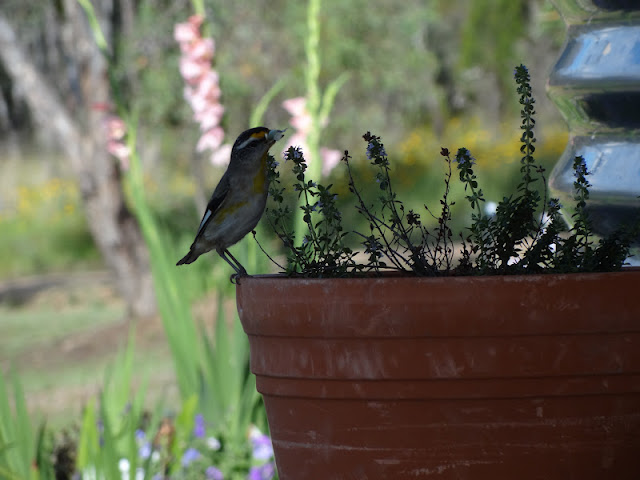The Great Northern Bower Bird last blog, and now, back at the farm, I am going to write a little about our Striated Pardalotes.(Pardalotus striatus)
The photo below is of this bird. Isn't it gorgeous? (I don't think the purists would appreciate me referring to a small bird as "gorgeous" but there it is. That's how I see it.)
 |
| You can see the bright yellow markings on its chest and above its eyes. |
 |
| I think that this is the female...she(?) is smaller than the other one...the male(??) |
 |
| Here is the pair....male in front of the female. |
Pardalotes are common all over Australia, with different types restricted to various areas. e.g. the Forty Spotted Pardalote is found only in a very small area of Tasmania. But our Striated Pardalote is one of the more common ones. It is found practically Australia wide.
This pair has nested in the base of one of our pot plants.
 | ||
| The male is perched on the rim of the thyme pot plant. |
And beside that pot is the "nest"....it is in the base of the pot beside the thyme. Both pots sit on one of our tank-stands.
 |
| Yes, the birds enter via the rectangular opening at the base of the pot. |
 |
| There...can you see a Pardalote head peeking out from the pot? |
There is no way to see into their nest, so I have no idea how many eggs have been laid, or how many will hatch, but both birds are busy feeding their young.
They seem to take it in turns to get food.....one stays in the nest while the other searches for food.
When the food-carrier returns, the nest bird leaves and the food-carrier enters the nest.
They communicate by song.
The series of photos below shows the birds with food in their beaks.
It is difficult to see exactly what is being carried inside to the baby bird/s, but you will see a grub or millipede, and various flying insects.
 |
| There on the left-hand pot is a Pardalote with a grub/worm/millipede in its beak. |
 |
| It looks like a small white butterfly is "dinner" |
 |
| ......and for variety, a yellow-winged insect. |
 |
| ...and another grub |
 |
| ...and this looks like a small grasshopper. |
I am deriving a lot of pleasure from watching these two small birds tend their nest.
And of course, I hope to see the new birds in the next few weeks.

How patient were you, waiting and watching, to capture these beautiful photos?! What an opportunistic pair of Pardalotes to find such a great spot for their nest, out of harm's way. And what an amazing variety of food they brought to feed their young. Your photos are just getting better and better. Thank you for such joyful shots of nature.
ReplyDeleteThank you Rosaleigh, for those kind words. And the pair is still busy....I think that we may see babies/ a baby (or is it a fledgling?) soon.
ReplyDelete